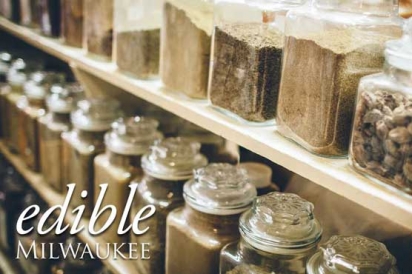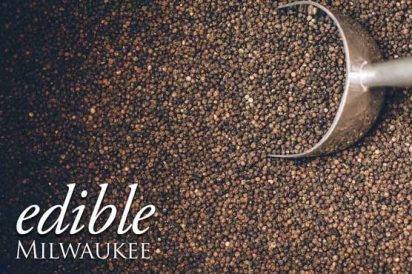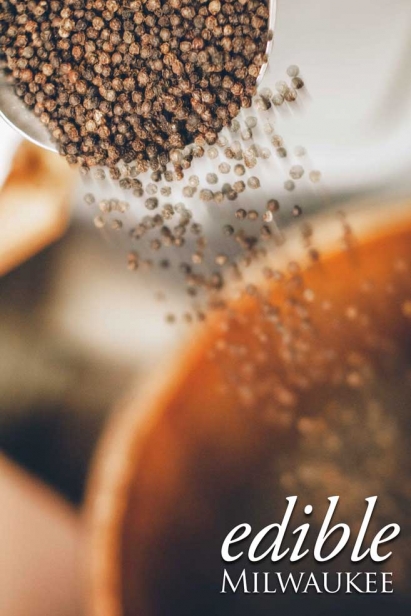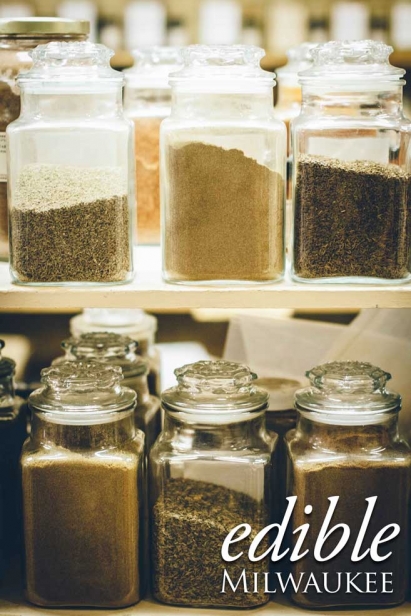By Way of Spices
The European Exploration of Wisconsin
Few things conjure the spirit of the holidays better than the scent of cinnamon, cloves, vanilla and nutmeg. These flavors have long been popular with Milwaukeeans. In 1846, Water Street grocer Frederick Wardner announced in the Milwaukee Daily Courier that he had just returned with the largest stock of dry goods and groceries, with special note made of ginger, nutmeg, cinnamon, cloves and pepper, that “has ever been exhibited to the good people of Wisconsin.”
There’s something mystical about the idea of spices, invoking images of brightly colored mounds of seeds, flowers, and bark in an Eastern bazaar. While the terms are sometimes used interchangeably in the kitchen, herbs and spices are different. Herbs are the leaves of plants, while spices come from the roots, bark and seeds. Some plants provide both herb and spice, like cilantro, the leaves and coriander, the seeds of the cilantro plant. Most spices originate in the tropics, growing 15 degrees above or below the equator. Herbs, on the other hand, can be more temperate.
Demand for trade goods from Asia, especially spices like cinnamon and pepper, was high in the Middle Ages. But the distance and number of middlemen involved made these goods too expensive for any but the wealthiest of Europeans in the 1300s and 1400s.
The secret behind the spice trade was simple: huge demand and a tightly-controlled supply. The drive for more (and cheaper) spices drove Europeans westward in search of an alternative sea route to Asia. Among the first was Christopher Columbus who aimed for India but bumped into the Americas instead. To appease his creditors for his failure, Columbus named the New World natives he met “Indians” and their chilies “pepper,” two names that have confused people ever since.
When a shortcut through or around South America proved elusive, European powers, particularly France, turned their attention to the possibilities of a route through North America.
The New World was not unknown to France. French sailors had begun crossing the Atlantic for fish and fur in the early 1500s. Their knowledge along with the work of explorers like Jacques Cartier charted the northern and eastern edges of the continent for France. Cartier’s three expeditions along the St. Lawrence River in search of gold, spices and other riches, enabled France to lay claim to the lands that became Canada.
And it was from there that French explorers like Etienne Brule and then Father Jean Nicollet, still in search of a route to Asia, made landfall in Wisconsin in the 1630s. The French didn’t find their long dreamt of seaway here, but they did find a rich source of furs that drove the Wisconsin economy for two centuries.
And yet spices, nonetheless, became an integral part of Wisconsin’s culinary story. In the 19th century, the state’s German residents made meat packing a major economic engine in Milwaukee. These meat packers needed spices to make their products, namely sausage, more flavorful, so a robust seasoning and flavor industry blossomed that’s still around today, flavoring far more than just meat.
The seasoning and flavor industry is an industry dominated by giants. The Campbell Soup Company, for example, opened its Milwaukee spice plant in 1966. All of the company’s flavorings and spices for the U.S. market originate in this south side plant. Wixon and Asenzya are among the other large Wisconsin spice companies.
But Milwaukee is also home to two renowned consumer-oriented spice businesses, both the product of one family.
Ruth and Bill Penzey, Sr., founded The Spice House in Milwaukee in 1957. The store originally sold coffee and tea along with spices, but transitioned to focus on spices exclusively. A good decision, says daughter Patty Erd, who now co-owns the shop with her husband, Tom Erd, because “the tea and coffee would take on the flavors of the spices.”
Erd grew up in the shop, earning her allowance by working weekends. In the early 1990s, the Penzeys lost the lease to their space and considered closing the shop. Patty and Tom urged them to move to a vacant space across the street. Instead, the Penzeys sold the shop to the Erds in 1992. There are now five Spice House locations in Illinois and Wisconsin.
The process of finding quality spices is easier than it used to be but still challenging for small stores. Most brokers only want to work with bigger companies.
“My dad would call people overseas trying to connect and to find products in small amounts,” says Erd. “It was hugely time consuming and hard to determine quality.”
The Spice House sources most of its spices from brokers. When they can go local, they will. Black garlic, mustard, and maple sugar are among the store products from Wisconsin.
Everything is ground and blended in house. While whole spices can last several years, ground spices lose the volatile oils that make them potent.
“Replace your spices!” exclaims Erd with a laugh. “The set you got as a wedding gift 20 years ago isn’t good anymore.”
Each week, an employee spends three hours grinding one hundred pounds of Vietnamese cinnamon, one of the most popular spices in the shops. Some of the newer Spice House locations even have a window so people can peer into the blending room.
“Everything is really fresh,” says Erd. “And because we’re a small shop, we can keep up with the changing tastes of consumers pretty well. Right now, [London chef Yotam] Ottolenghi has made Middle Eastern spices really popular.”
Erd isn’t the only Penzey in the spice business. Her brother Bill started Penzeys Spices first as a catalog business and then opened a retail outlet in 1994. Today, the Wauwatosa-based Penzeys Spices has stores in more than two dozen states. Like Erd, Penzey, too, grew up working in their parents’ store. With two spice businesses in the family, relations between the two siblings haven’t always been positive but Erd says they are now on good terms.
“There are plenty of spice customers for everyone,” says Erd. Indeed, Mequon is home to another spice store, The Spice & Tea Exchange. Lisa Straub came to the spice business after being downsized from corporate America. She’d always loved to cook and she and her husband decided it was time to embark on a different path. They opened Wisconsin’s first branch of the Florida-based company in 2013.
“We want to demystify spices for people,” explains Straub. “Many people associate spices with spicy, but they are not the same. Spices are flavor.”
The store specializes in custom blends. Everything is mixed in-house so Straub says they can accommodate every dietary need, allergy, or preference. Straub says many of her customers grew up with salt, pepper and maybe cinnamon so education is a huge part of her day.
“You can eat chicken seven days a week, but it can be completely different each day by changing the spices,” says Straub. “You don’t have to be a trained chef to cook well with spices.”
Straub loves spices so much she carries a fiery blend in her purse.
“I like a little kick with my food, so I grind it on top of everything,” laughs Straub.
Besides the store, the Spice and Tea Exchange can also be found at farmer’s markets in Cedarburg, Grafton and West Bend, among others.
Surrounded by spices her whole life, you might think The Spice House’s Erd wouldn’t have a favorite, but she’s quick to respond: vanilla beans.
“Vanilla is so complex and wonderful,” explains Erd. “But we’ve been so bombarded with fake vanilla flavoring by the food industry that we’ve come to see it as plain and generic when it is anything but.”
That’s really the story of all spices: pungent, complex, and once more valuable than gold. Centuries of exploration and global trade began in pursuit of a more flavorful dinner. Although cinnamon and pepper are no longer luxury items for most of us, spices are a direct line to centuries of human history and desire, bottled.
“Spices once drove us apart as nations competed for them,” says Straub. “Now spices bring us together around the table.”










